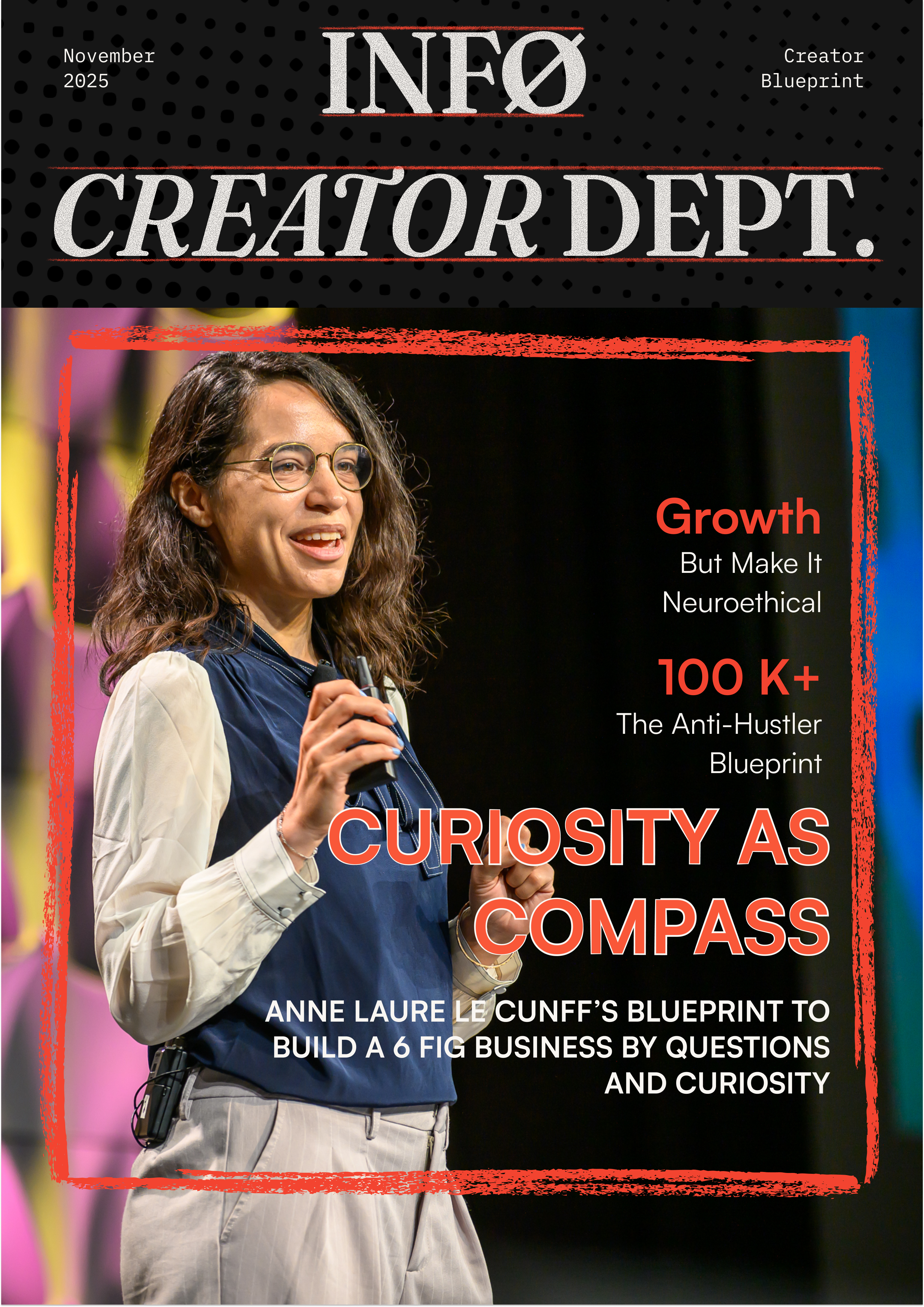Anne-Laure Le Cunff: The woman who built a 6-fig business by questions and curiosity
She had the job people manifest on moodboards.
Google. London. Health-tech.
A clean LinkedIn headline. Respectable money. Decent coffee. Just enough prestige to put “I’m doing well” on autopilot.
But inside, the circuits were frying.
Not all at once. Not loudly. Just a slow fizz in the background — like a charger that gets hot even when unplugged.
Burnout wasn’t a bug in the system.
It was the system.
And like any good scientist in denial, Anne-Laure Le Cunff did what most people wouldn’t even Google:
She nuked the prestige.
Walked away from one of the safest, most glorified professional tracks in the world — not to “find herself,” but to study the brain.
Then she rewired her own.
Fast-forward through the debris and you’ll find her now:
- Audience in the six-figures
- PhD in progress at the intersection of neuroscience and behavior
- A cult-favorite productivity lab (Ness Labs)
- And a book, Tiny Experiments, that quietly shivs the entire hustle-industrial complex
This isn’t a story about “balance.”
It’s a thesis on how default operating systems are incompatible with complex human minds. Especially when those minds live online.
We’ll come back to Anne-Laure. But here’s the real question her story unlocks:
What if burnout isn’t failure?
What if it’s feedback?
And what if creators — the new decentralized R&D department of the economy — are just early beta testers for a larger system malfunction?
Now, buckle up, this could get heavy and weird.
🧭 READ THIS FIRST: How to Approach This Deep Dive Without Melting Your Brain
Welcome to The Info Creator Dept.
This isn’t just a blog post. It’s an unlicensed field manual disguised as a case study.
A rogue operating system for creator-educators.
Part documentary. Part blueprint. Part breakdown of someone’s eerily replicable online empire.
⚠️ And yes—it’s a DEEP DIVE, and it’s long.
But no—you’re not supposed to “read” it.
You’re supposed to explore it. Like a secret archive. Or a suspiciously well-organized conspiracy board.
Here’s how to survive the dive (and steal its secrets)
🔍 1. Skim Like a Scientist, Not a Student
Don’t start at the top. Let your curiosity lead.
Scroll the headers. Chase rabbit holes. Jump around like it’s an interactive Netflix doc.
✍️ 2. Take Notes on What Feels “Strangely Useful”
If something makes you whisper, “Wait… I could use that.”
Pause. Highlight. Screenshot. That’s the signal. Follow it.
🧪 3. Don’t Memorize. Prototype.
This is not school. This is war.
You don’t need to learn everything. Just steal the weapons and remix them into your business.
🧠 4. Come Back When You’re Stuck
Bookmark it. These pieces are built to be revisited.
When your growth plateaus or you’re drowning in content chaos—return here. Something new will click.
📚 5. Share It If You Want More Like This
These deep dives take 100+ hours, 50+ tabs, and mild existential panic to build.
If you find value, a share = signal for more.
This is not content.
It’s a creator operating system.
Read it like you’re trying to escape the simulation.
- 🧾 Micro-Burnout, Macro-Delusion
- ⚙️ Prologue: The Anti-Hustler Blueprint
- Chapter 1: THE CHAOTIC SAGE WHO BUILT A $1M+ IDEA SANCTUARY
- 📐 SECTION I THE ARCHITECTURE OF A CALM CHAOS BUSINESS
- 📐 SECTION II HER IDENTITY STACK: CHAOTIC SAGE ENERGY
- 📐 SECTION III THE PHILOSOPHY BEHIND NESS LABS
- 1. Curiosity as Compass
- 2. Learning in Public
- 3. Mindful Productivity
- 4. Tiny Experiments
- 📐 SECTION IV: Asymmetry Moves
- 🔥 SECTION V: Build Like Anne—Without Copying Anne
- 🧩 TL;DR: The Ness Labs Blueprint
- CHALLENGE FOR THE READER
- Chapter 2: Mindfulness, Monetized
- Chapter 3: Build once, compound forever
- 🎯 Core Offers: The Brain-Based Builders
- 🧩 Supporting Nodes in the Neural Network
- 🧠 The “Slow Growth Stack” Matrix
- Chapter 4: How Anne-Laure hacked growth using intention, not hustle
- 🧠 The Anti-Growth Growth Stack
- Chapter 5: The Content Machine That Turned Thoughts Into Traction
- Chapter 6: Brand Osmosis
- Chapter 7: The Anne-Laure Le Cunff Protocol
- Epilogue: What We Talk About When We Talk About “Creator Economy”
- Chapter 8: Conclusion – The Rise of the Info Creator
- 🧭 READ THIS FIRST: How to Approach This Deep Dive Without Melting Your Brain
🧾 Micro-Burnout, Macro-Delusion
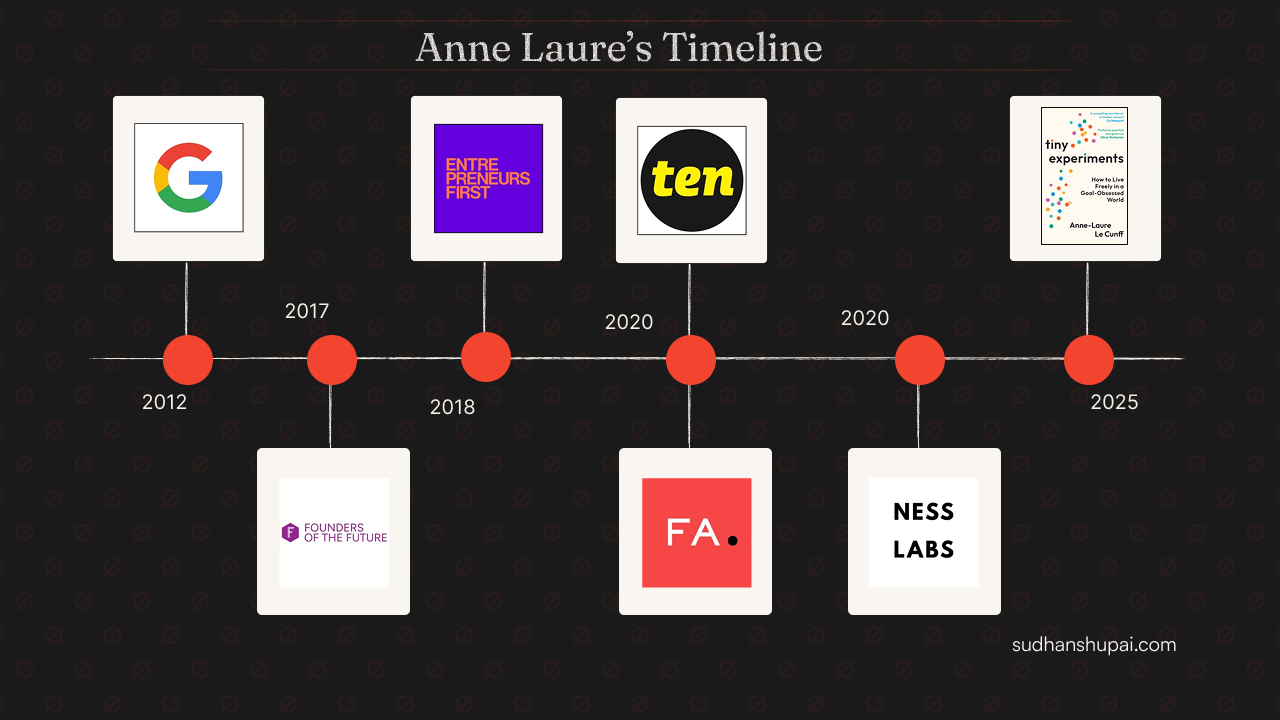
Let’s zoom out for a moment.
The Anne-Laure arc isn’t an anomaly. It’s the tip of a larger economic pattern — one I kept seeing during my sabbatical, working with creators, founders, and mid-career professionals melting under the weight of productivity cults and identity inflation.
There’s a new kind of burnout sweeping through creators and knowledge workers. I call it:
🧠 Creative Dissonance Fatigue
The chronic exhaustion that comes from holding two contradictory beliefs:
- “I have to optimize everything I do.”
- “Creativity cannot be optimized.”
Creators don’t burn out because they’re weak.
They burn out because they’re running conflicting operating systems: one built for algorithms, the other for art.
📊 Flowchart of Dysfunction:
Here’s what that tension looks like in the wild:
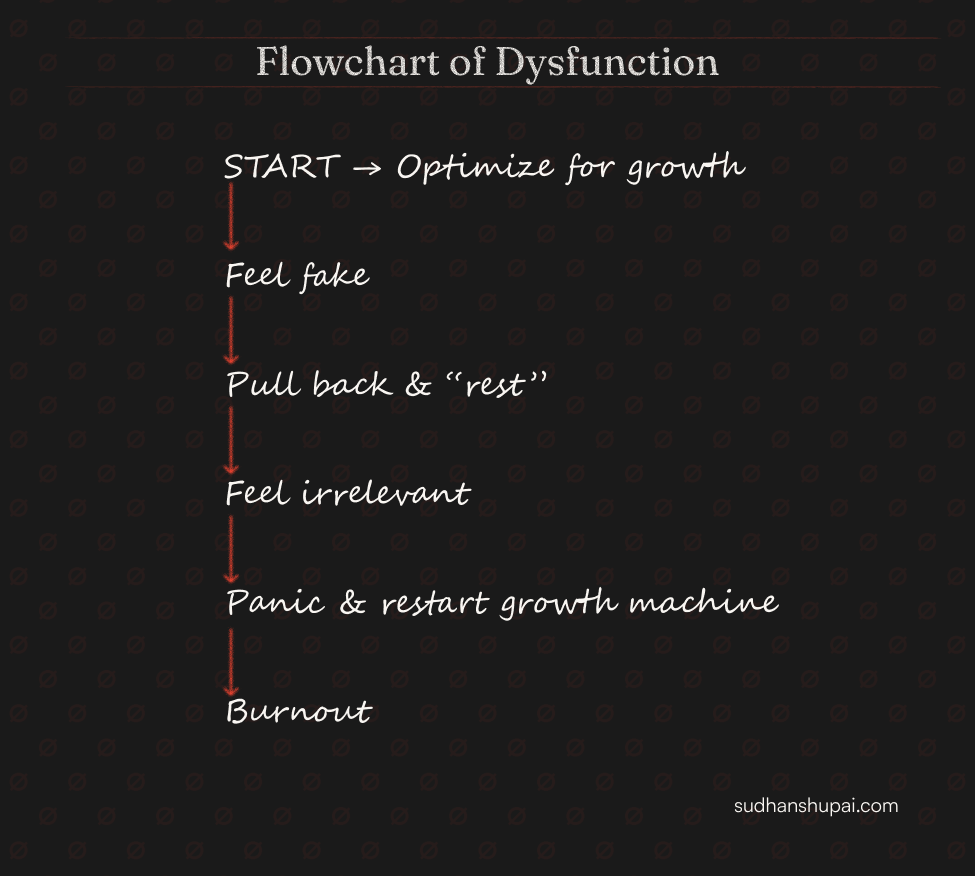
This loop isn’t just personal. It’s systemic.
It mirrors the larger contradictions of modern economic logic — where identity becomes labor, and attention becomes currency.
And the old institutions? They were never meant to handle this kind of feedback loop.
Not schools. Not corporations. Not even your favorite productivity app.
🧠 A Theory Worth Testing
So here’s what I’m building — and breaking — in public:
A map of the new Cognitive Creator Economy, where your mind is the product, your burnout is data, and your business model better be trauma-informed.
It’s part research, part recovery.
All field-tested on burnt-out geniuses and caffeinated introverts.
We’ll trace it all:
- From micro burnouts to macro belief collapse
- From prestige addiction to platform fatigue
- From Anne-Laure’s lab notes to economic metaphysics
And through it all, one core hypothesis:
“The systems that made us successful are now the very things eroding our signal.”
The only way out?
It might just be through the rubble.
⚙️ Prologue: The Anti-Hustler Blueprint
Or how Anne-Laure Le Cunff turned neuroscience into a slow media empire
Imagine being so radically curious — so quietly obsessed with how the brain works — that you accidentally invent a whole new category of work.
Now imagine doing it without ads.
Without 80-hour weeks.
Without chasing the algorithm like a caffeinated hamster.
Yeah. Anne-Laure Le Cunff really did that.
She didn’t “go viral.”
She went deep.
Launched a quiet little writing lab called Ness Labs.
Wrote with clinical precision and soft power.
Landed 6,000+ subscribers in four months, without a growth hack in sight.
Then she scaled.
But not fast.
On purpose.
While most creators were playing volume games, Anne-Laure was doing what scientists do:
Running experiments.
Logging results.
Staying weirdly consistent.
And somewhere between the essays, extensions, and experiments, she built a multi-income media business that feels less like a funnel and more like a forest.
🧠 What Makes This Wild?
Most people build brands by mimicking whatever works.
Anne-Laure built one by mining her obsessions.
Most creators chase attention.
She chased understanding.
Then sold the clarity.
In doing so, she coined a new creator archetype:
The Mindful Experimenter — someone who scales not with hustle, but with hypotheses.
And that changes everything.
Because this blueprint isn’t about copying her moves.
It’s about stealing her mindset.
The one that let her win on her own strange, precise, and principled terms.
🔍 What You’re About to Get:
This isn’t a profile. It’s a dissection.
You’re about to see how one woman reverse-engineered her burnout into a blueprint — and why it works so well in the age of creator collapse.
We’ll break down:
| Module | What You’ll Learn |
| Brand Architecture | How she turned neuroscience into narrative leverage |
| Business Model | From Chrome extension to Calm-fueled content lab |
| Messaging DNA | Why “quiet and clear” outperforms “loud and optimized” |
| Growth Systems | How she scaled with low-stimulus, high-signal systems |
| Leverage Playbook | When and how she scaled, hired, and diversified |
We’ll also explore:
- How “mindful productivity” became positioning, not just content
- Why burnout wasn’t a weakness — but a brand asset
- And how her Tiny Experiment Thesis could help you rebuild your own creator system
⚠️ Reader Warning:
After this, you may never look at “creator productivity” the same way again.
Because what Anne-Laure built isn’t a niche.
It’s an operating system.
And it might be the most sustainable creator business you’ve never studied—
until now.
Chapter 1: THE CHAOTIC SAGE WHO BUILT A $1M+ IDEA SANCTUARY
Anne-Laure Le Cunff didn’t start Ness Labs with a business model. She started with a mental model.
While the internet screamed “hack your hustle,” she whispered:
“Mindful productivity.”
Welcome to the world of Ness Labs—part creator lab, part internet monastery, part income-generating second brain.
In a creator economy fueled by speed, virality, and dopamine-chasing content loops, she built a slow internet garden.
A place for curious minds. For knowledge workers who don’t want to burn out just to cash in.
What started as a personal blog in 2019 soon bloomed into a comprehensive system of ideas, resources, and revenue: newsletters, online courses, a membership community, and a book deal. But more than what Ness Labs sells, the real story is how it was built—and why it still stands out.
📐 SECTION I THE ARCHITECTURE OF A CALM CHAOS BUSINESS
How a thinking system became a business model
Anne-Laure didn’t scale a product.
She scaled a worldview.
Here’s the structure:
| Layer | What It Is | Why It Works |
| Core Philosophy | Calm productivity, mindful learning, metacognition | Resonates with knowledge workers burned out by hustle culture |
| Content Engine | 400+ original essays, 60+ mental models, evergreen topics | SEO goldmine + timeless insight = compounding IP |
| Offer Stack | Membership ($99/year), 5+ courses, paid newsletter ($5/mo) | Multiple entry points + recurring revenue |
| Growth Flywheel | SEO → Newsletter → Courses/Membership | Low churn, high LTV, slow organic growth |
🚨 Tactical Unlock: Her small bets newsletter → essay → course → membership loop is a self-contained product flywheel. You don’t need virality. You need flow.
📐 SECTION II HER IDENTITY STACK: CHAOTIC SAGE ENERGY
Where most creators fall into branding by accident, Anne-Laure engineered hers like a behavioral experiment.
She operates at the intersection of three archetypes:
| Archetype | How It Shows Up |
| The Sage | Deep research, psychology-backed insights, mental models |
| The Creator | Original visual frameworks, toolkit-building |
| The Caregiver | Mindful learning, “no hustle” ethos, calm productivity |
🎙️ “Come for the models. Stay for the meaning.”
That’s the voice. Academic, but warm. Sharp, but non-performative.
People don’t just follow Ness Labs.
They identify with it.
⚙️ The Differentiation Engine
Where most creators play for reach, Anne-Laure played for resonance.
She didn’t chase the algorithm. She designed a long-game ecosystem:
- Newsletter? Evidence-based and evergreen.
- Courses? Actionable without being overwhelming.
- Community? Focused on belonging, not just benefits.
In a world of growth hacks, she chose growth curves.
And her X-factor? Neuroscience. She weaponized her academic background to speak the language of the overwhelmed mind—grounded, trustworthy, never hypey. This positioned Ness Labs in direct contrast to bro-productivity brands chugging dopamine with a side of hustle porn.
📐 SECTION III THE PHILOSOPHY BEHIND NESS LABS
Most creators build content.
Anne-Laure built cognitive scaffolding.
“Learning is not a means to an end. It is the end.”
Ness Labs isn’t a brand. It’s a thinking dojo.
A system of first principles turned into practical business infrastructure.
Here’s the 4-part philosophy that fuels it:
1. Curiosity as Compass
“Turn uncertainty into curiosity.”
Curiosity isn’t a topic — it’s the niche.
And niches don’t scale. Missions do.
🛠️ Stealable Move:
Structure your IP around questions, not answers.
2. Learning in Public
Half-baked ideas > fake polish
Growth isn’t viral. It’s visible.
🛠️ Stealable Move:
Document your thinking while it’s forming.
Authority compounds faster when earned in public.
3. Mindful Productivity
GTD = outdated.
GCTG = “Get Clear to Get Going.”
Mental clarity = business leverage.
🛠️ Stealable Move:
Teach productivity as cognitive hygiene, not performance porn.
4. Tiny Experiments
No launch plans. Just feedback loops.
The lab mindset isn’t just metaphor. It’s method.
🛠️ Stealable Move:
Weekly micro-tests → Data → Product ecosystem
This attracts seekers, not scrollers.
People pay because her brand represents something deeper than just “get smarter.”
🧠 From Blog to Brain Brand
Anne-Laure didn’t build a brand.
She became a brand.
By reverse-engineering from identity outward:
- Identity-first: Curious, grounded, trustworthy
- Voice-first: Calm, nerdy, non-hype.
- Community-first: Self-sustaining, documented, recursive
She didn’t build a content treadmill.
She built a self-upgrading system.
📐 SECTION IV: Asymmetry Moves
Let’s contrast Anne-Laure’s model with the average creator business:
| Trait | Typical Creator | Ness Labs |
| Content | Volume-driven | Depth-driven |
| Revenue | 1:1 Services or Ads | Productized Knowledge |
| Brand | Personal = Performative | Personal = Philosophical |
| Growth | Virality | Compounding Trust |
| Philosophy | “Scale fast” | “Grow true” |
📉 Takeaway:
Volume is fragile. Systems compound.
And that’s how Ness Labs quietly crossed the $1M+ mark—without a single “10X Hack” funnel.
🔥 SECTION V: Build Like Anne—Without Copying Anne
Let’s be clear:
You’re not Anne.
You don’t have to be.
But you can steal her architecture:
- Build an identity lab, not a content treadmill.
- Use Sage clarity to earn trust.
- Inject Creator play to keep it fresh.
- Run weekly “tiny experiments.” Document your results.
Systematize what works. Share it. Monetize it.
The creator economy doesn’t reward the loudest.
It rewards the clearest.
And Anne-Laure? She’s clarity with a capital C.
🧩 TL;DR: The Ness Labs Blueprint
- Archetypes: Sage + Creator
- Core Philosophy: Experiments > Hustle, Curiosity > Certainty
- Content Loop: Essay → Product → Community
- Monetization: Calm IP Stack = Courses + Newsletter + Community
- Differentiator: Neuro-backed, burnout-proof, algorithm-resistant
- Playbook: Go slow. Get sharp. Share early.
“You don’t need a map. You need a compass.”
– Anne-Laure
CHALLENGE FOR THE READER
Could you build a calm $1M knowledge business without becoming a content machine?
If yes, Anne-Laure’s model is your blueprint.
If no, this series will help you rewire your strategy.
Chapter 2: Mindfulness, Monetized
“Build slowly, but never stand still.”
— Anne-Laure Le Cunff, somewhere between a neurology textbook and Notion doc
Anne-Laure Le Cunff didn’t begin with a funnel.
She began with a feeling.
Like many great creators-turned-founders, she had no launch plan, no CAC-to-LTV ratio, no landing page with an urgent countdown timer.
What she did have was a slightly obsessive fascination with how brains work.
And a desire to write online — not to scale a business, but to understand herself.
The internet rewarded her anyway.
Well… eventually.
💸 Phase 1: Ramen-Grade Revenue, Brain-Hug Vibes
The newsletter that paid in serotonin and Stripe pings
- A quiet dispatch called Maker Mind enters the inbox arena.
Part mindful productivity digest. Part neurosci zine. Part personal lab report.
It wasn’t optimized. It wasn’t aggressive.
It felt more like “here’s what I’m learning and unlearning — join me?”
But then came the upgrades:
- A paid newsletter tier.
- Digital products (think: curated Notion libraries for nerds with burnout).
1:1 coaching, selectively offered to early readers.
Result?
Not fireworks. But flickers.
Artisanal ramen money. With mushroom topping. And enough to keep the lights on.
💡 Takeaway: A niche email list will always outperform a random audience when you’re selling education, not entertainment.
Source: MetaLearn Podcast, ML158
🚀 Phase 2: Collector No More
From note-hoarder to creative economist
Her first real monetization arc?
A digital course with a deceptively philosophical name:
From Collector to Creator
It was a rallying cry for every intellectual maximalist who spent more time saving ideas than using them.
The course didn’t just offer lessons.
It offered a mindset shift:
“Information isn’t leverage. Action is.”
But here’s the unlock: she didn’t just sell a course.
She built a membership-powered learning ecosystem:
| Layer | Purpose |
| 🧪 Live workshops | To test thinking in real-time |
| 🧑🤝🧑 Peer spaces | To remove intellectual isolation |
| 🛠 Exclusive tools | To build faster, smarter, calmer |
| 💰 Recurring revenue | Without high-churn chaos |
Outcome?
- 120,000+ newsletter subscribers
- 2,000+ paid students
- Business sovereignty = pricing leverage
🔁 Phase 3: IP Overload Avoidance Protocol
How to monetize your mind without becoming a digital sweatshop
Most creators fall into the course addiction loop:
Make course → Launch course → Burn out → Repeat
Anne-Laure swerved.
Instead of producing more content, she diversified her intellectual property:
🧠 Published a book: Tiny Experiments
🗣 Led corporate workshops: mindfulness meets performance
🧘♀️ Built a Chrome extension: Teeny Breaks — a micro-intervention for digital burnout
None of these were growth hacks.
They were micro-IP plays — slow-burning assets that compound over time.
She didn’t build a funnel. She grew a forest.
Where every product was a branch, and every insight fed the roots.
🌲 But What Does the Forest Look Like?
It looks like this:
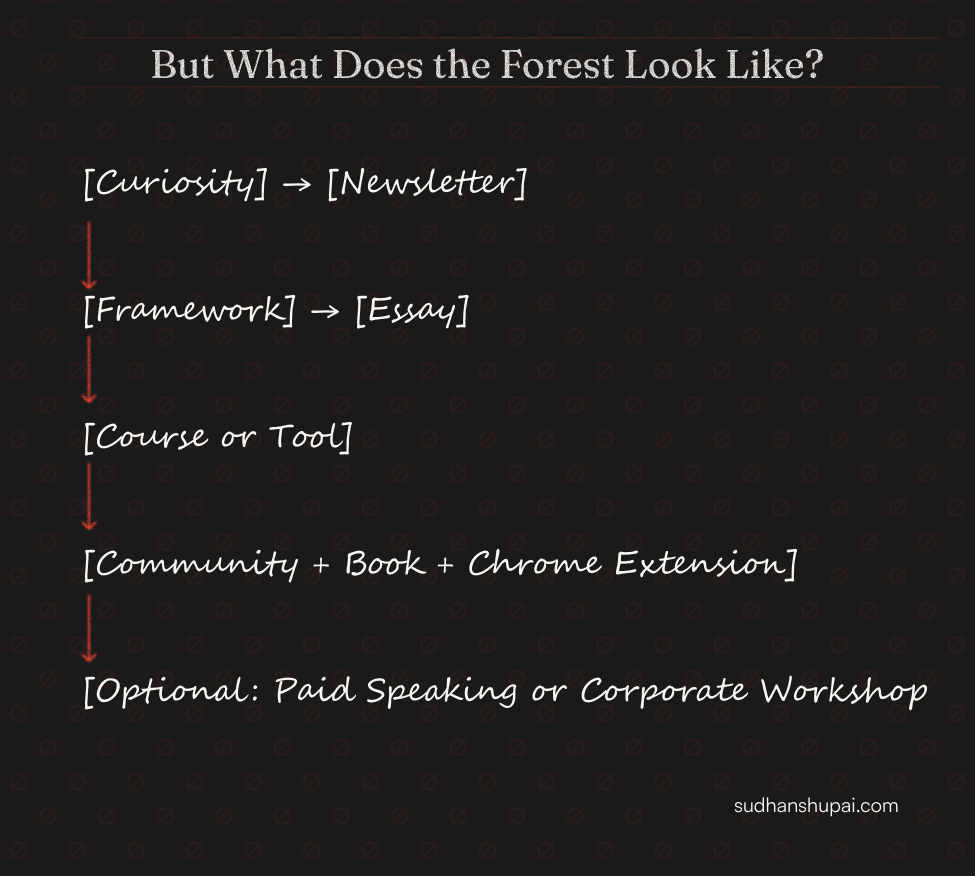
Each leaf on the tree is powered by the same sap:
Mindful experimentation.
This isn’t monetization.
It’s idea ecology.
🤯 The Mindfulness Monetization Matrix
Let’s decode her operating logic.
| Variable | Typical Creator | Anne-Laure |
| Revenue Driver | Funnels | Flywheels |
| Burnout Risk | High | Low (by design) |
| Identity | Content Machine | Thought Gardener |
| Growth Lever | Social Proof | Cognitive Trust |
| Product Stack | Course after course | Diversified IP with soul |
She didn’t build velocity.
She built vibe-driven volume.
🧩 TL;DR – Mindfulness, Monetized (Without Selling Out)
Anne-Laure’s slow business blueprint works because:
- Her products feel like extensions of her brain, not marketing departments
- Her newsletter isn’t a content dump—it’s an invitation to think slower
- Her community is built around meaning, not access
- Her business grows at the speed of clarity, not noise
She’s proof you don’t have to sell your soul to build a sustainable creator economy business.
You just need:
A brain, a compass, and a little audacity to monetize without becoming a machine.
Chapter 3: Build once, compound forever
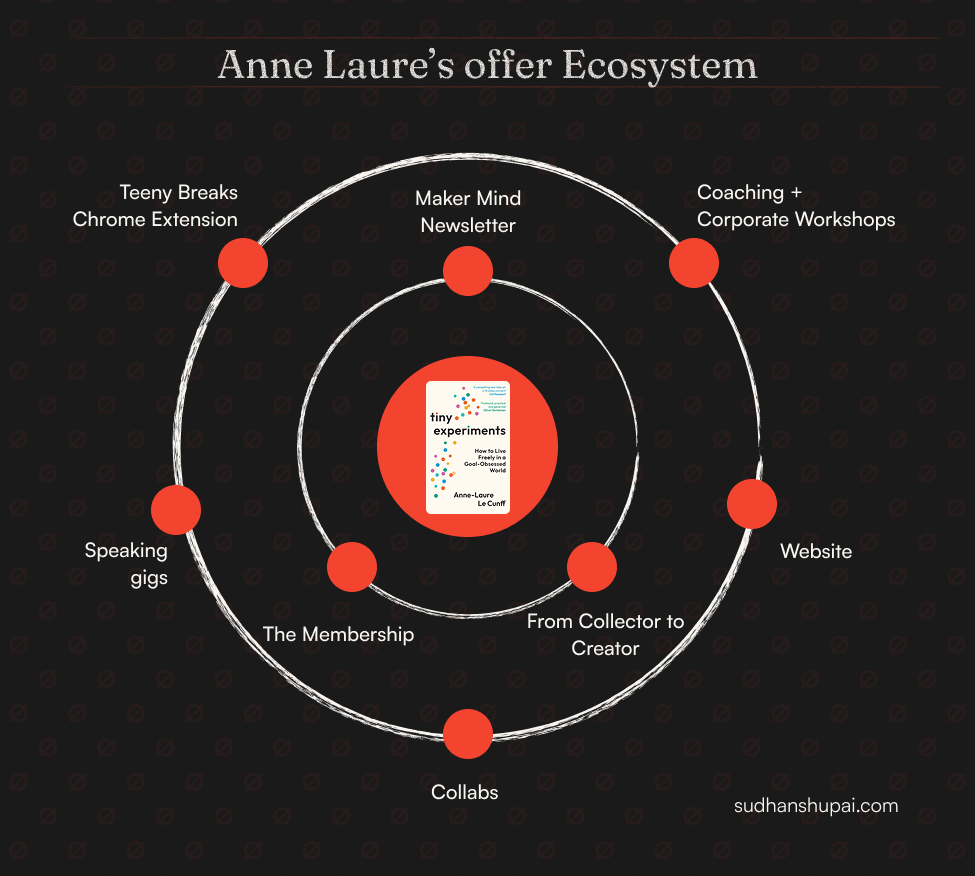
You don’t escape the freelancer matrix by launching a course.
You escape by building a system that lives, breathes, and evolves with you.
Anne-Laure Le Cunff didn’t build a funnel.
She built a mental operating system — equal parts university, playground, and quiet rebellion against hustle-fueled productivity porn.
This is not a product stack.
This is an ecosystem with a nervous system.
Let’s dissect its anatomy.
🎯 Core Offers: The Brain-Based Builders
These are not “monetization plays.”
They are strategic neural nodes in an experience designed to scale meaning, not noise.
1. 🧠 Maker Mind Newsletter — The Cognitive Entry Drug
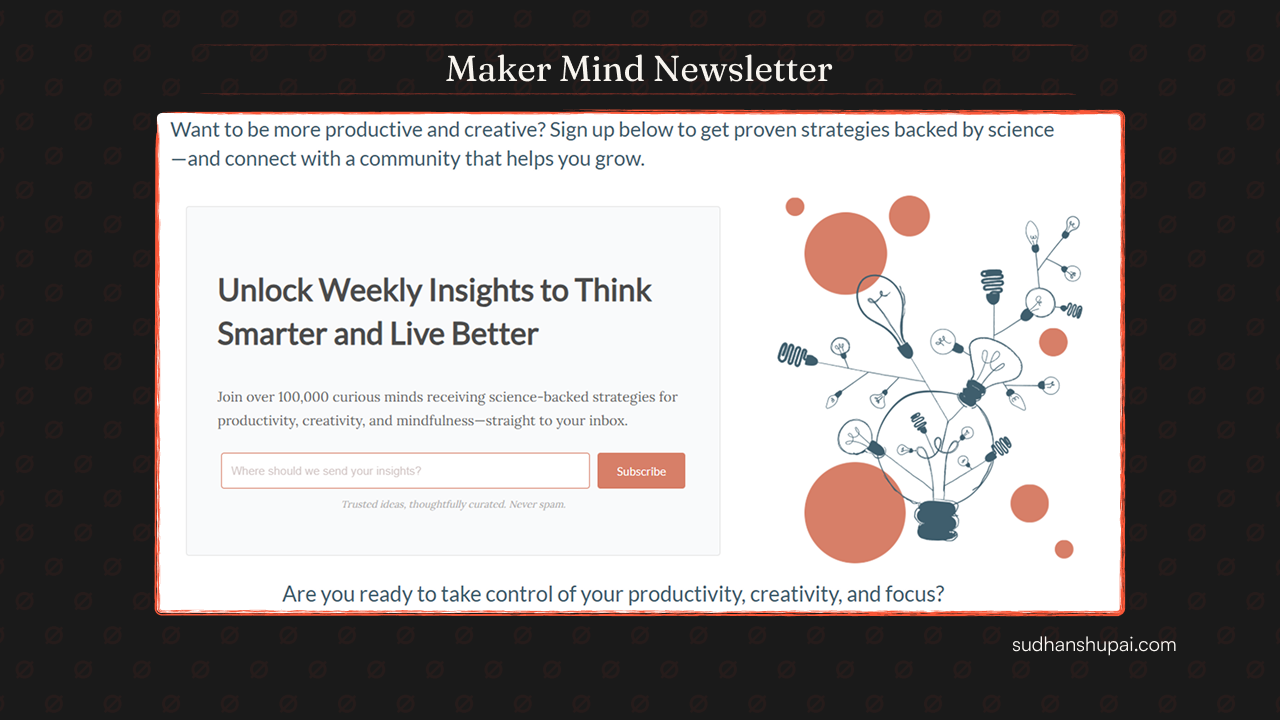
Weekly brain candy. Psychology meets Notion meets existential micro-crises.
- The free tier builds trust.
- The paid tier builds intimacy.
- Together, they form a segmentation lab disguised as a mailing list.
Positioning: A gym membership for your mind
Function: Traffic engine + product incubator + psychological opt-in
🧪 Smart move:
She didn’t use the newsletter to push offers. She used it to pre-test ideas.
Every essay was a probe. Every reader reply was an A/B test.
Source: MetaLearn Podcast, ML158
2. 🎓 From Collector to Creator — The Flagship Identity Shift
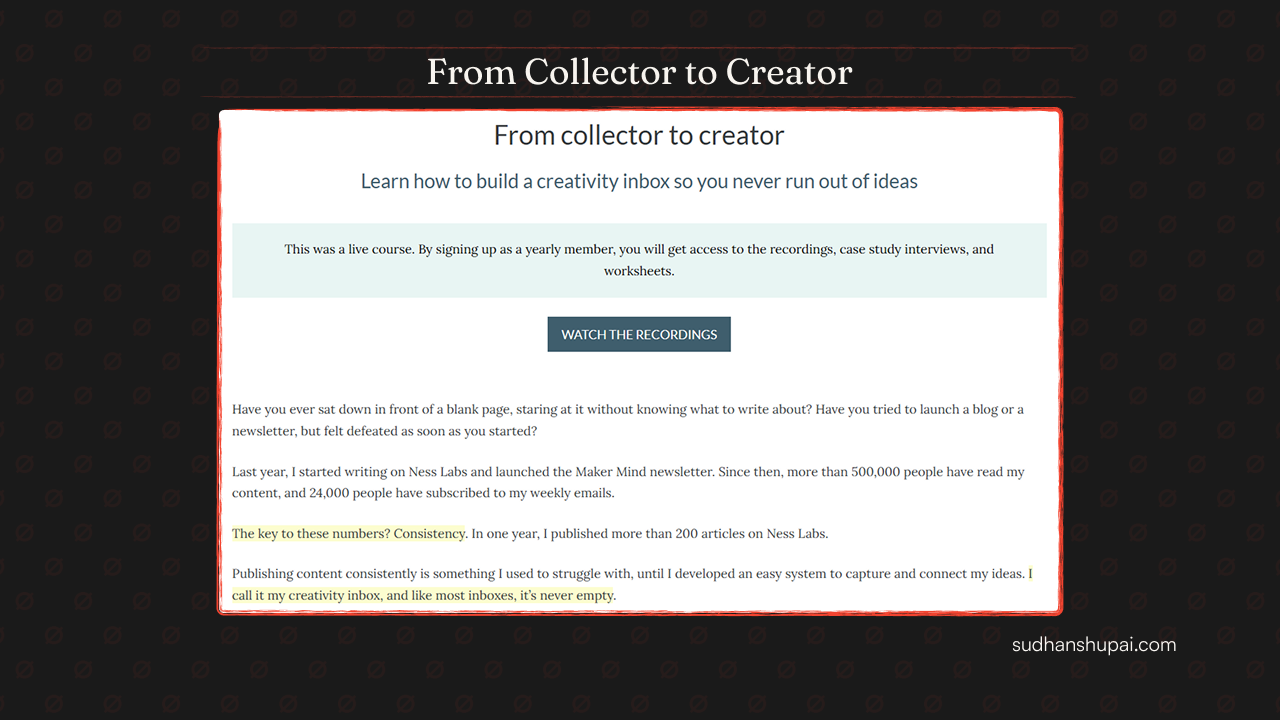
A course? Yes.
But more like a philosophical intervention for hoarders of digital knowledge.
- Self-paced, evergreen, quietly rigorous
- Wrapped in Notion, laced with psychology
- A subtle takedown of passive productivity culture
This wasn’t “how to get things done.”
It was “how to stop consuming and start becoming.”
Strategic twist:
The real product isn’t the course.
It’s the identity transformation students undergo by the end.
3. 🫂 The Membership — A Community With a Cognitive Ethos
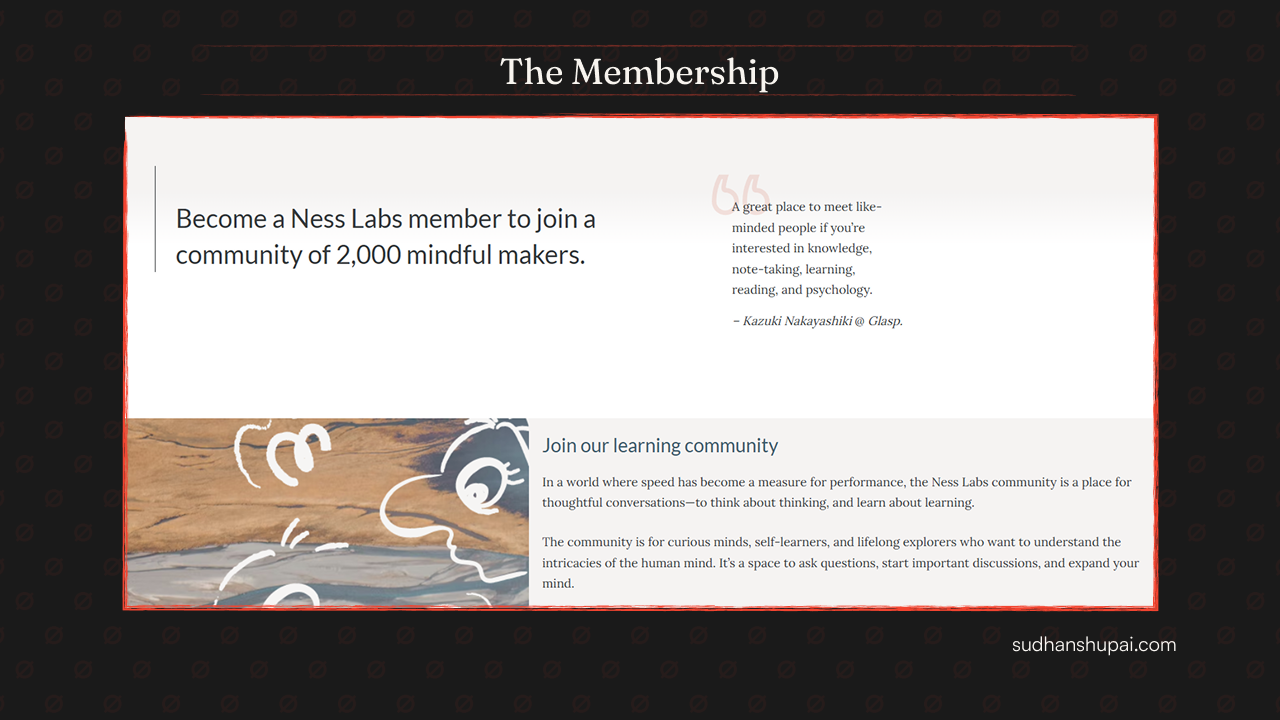
Part lab. Part support group. Part anti-Mindvalley.
- Live workshops
- Peer experiments
- Creator coworking
- Soft accountability with hard science underneath
You’re not buying access.
You’re buying belonging.
“What if Mindvalley wasn’t cringe?” — probably no one. But that’s the vibe.
🔍 Brand Insight:
She didn’t monetize exclusivity.
She monetized identity resonance.
🧩 Supporting Nodes in the Neural Network
These aren’t add-ons. They’re ecosystem enhancers — small bets that reinforce the core thesis.
🌱 Teeny Breaks Chrome Extension — Mindfulness by the Pixel
A tiny tool that gently interrupts digital overload.
A micro-intervention with macro-intent.
- Nudges users to take mindful breaks
- Built-in brand reinforcement
- Opt-in wellness, not push-notification tyranny
🧠 Meta-Level Win:
It doesn’t demand attention.
It respects it.
🎤 Coaching + Corporate Workshops — Neuro-Capital, Licensed
She took her neuroscience + tech background, stripped out the corporate nonsense, and started running workshops for orgs that needed mental clarity more than another OKR.
This is IP licensing in disguise.
And it’s priced like it.
🧠 The “Mindful Funnel” — A Circular Journey, Not a Funnel
Visualize this not as a sales path — but as a cognitive loop:
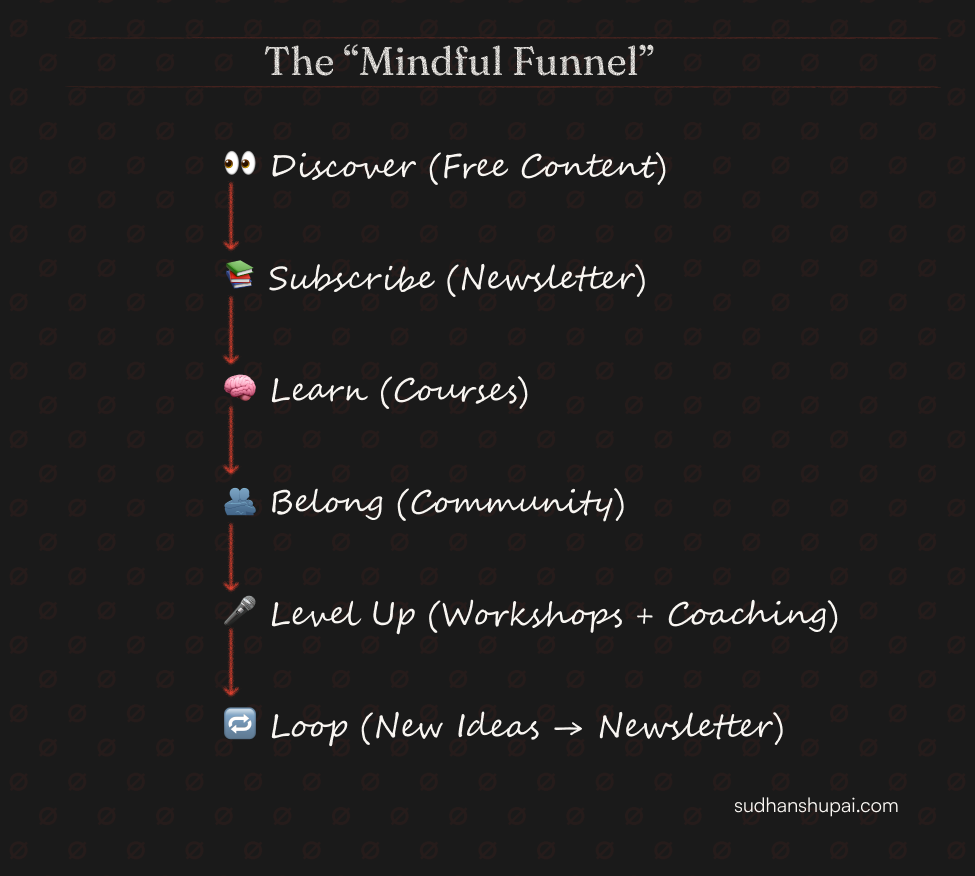
This is not a funnel.
It’s a circular economy of trust.
A digital garden with cognitive compounding built in.
🧠 The “Slow Growth Stack” Matrix
A business model for people who don’t want to scream on the internet.
| Tier | Product | Ecosystem Role | Leverage |
| Top | Coaching + Workshops | Authority builder | High trust, high ticket |
| Middle | Courses + Community | Value delivery | Evergreen, scalable |
| Base | Newsletter + Extension | Attention layer | Frequency + Feedback |
This isn’t stacking offers.
It’s stacking identities.
🧬 Creator Archetype: The Neuro-Gardener
Anne-Laure is not a creator.
She’s a neuro-gardener — growing IP the way permaculturists grow food: with care, layers, seasons, and systems.
She doesn’t launch.
She pollinates.
Her entire system is built on:
✳️ Loops over launches
✳️ Questions over content
✳️ Experiments over expertise
🧠 Core Equation:
If you want long-term retention, don’t just build offers.
Build worldview scaffolding.
A system people can live inside.
Chapter 4: How Anne-Laure hacked growth using intention, not hustle
“Most people market like they’re yelling into a void.
Anne-Laure built a signal so clear it made the void echo back.”
There’s a temptation in the creator economy to make noise and call it strategy.
But Anne-Laure Le Cunff did something far more dangerous.
She made sense.
No Facebook pixels. No YouTube funnels. No seven-email sequences promising “the exact swipe file that made me $47,839 in 2 days.”
Instead, she grew like a mycelium network: slow, smart, and deeply embedded.
🧠 The Anti-Growth Growth Stack
(Or how to build a movement without a megaphone)
Anne-Laure didn’t skip growth.
She just refused to optimize herself out of meaning.
Let’s reverse-engineer the engine.
🚫 Paid Ads? Hard Pass.
No paid campaigns. No retargeting rituals.
Why?
Because her system wasn’t powered by gas.
It ran on gravity.
Her content pulled people in—slowly, repeatedly—until staying felt more natural than clicking away.
✅ Organic Growth: Where the Bodies Are Buried
She didn’t “go viral.” She built resonance that couldn’t be ignored.
1. SEO-Engineered Brain Food
Essays, but with search intent.
Every article was a Google-friendly Trojan horse for mindful rebels.
Structure like Wikipedia. Depth like a neuroscience textbook.
Links like a rabbit hole you forgot you fell into.
Her content wasn’t made to perform.
It was made to stick to your hippocampus.
2. Newsletter as Neural Flywheel
Maker Mind wasn’t just an email list.
It was a habit-forming ritual.
120,000+ subscribers later, and it still reads like a love letter from your prefrontal cortex.
Article by article. Loop by loop.
A newsletter that monetizes trust, not tactics.
3. Podcasts as Borrowed Brains
Instead of building her own podcast empire, she hijacked others’ credibility.
MetaLearn. Microsoft WorkLab. Good Life Project.
She entered the room quietly and left with half the audience.
Every episode was a portable trust bridge to a new niche.
4. Social Media as Lab Journal
No memes. No “engagement bait.” No 32-part threads on “how to crush Q3.”
Instead:
Experiments. Reflections. Research breadcrumbs.
She didn’t tweet like a creator.
She tweeted like a researcher in love with their lab notes.
🤝 Partnerships & Collaborations
You don’t need virality when your friends are network effects.
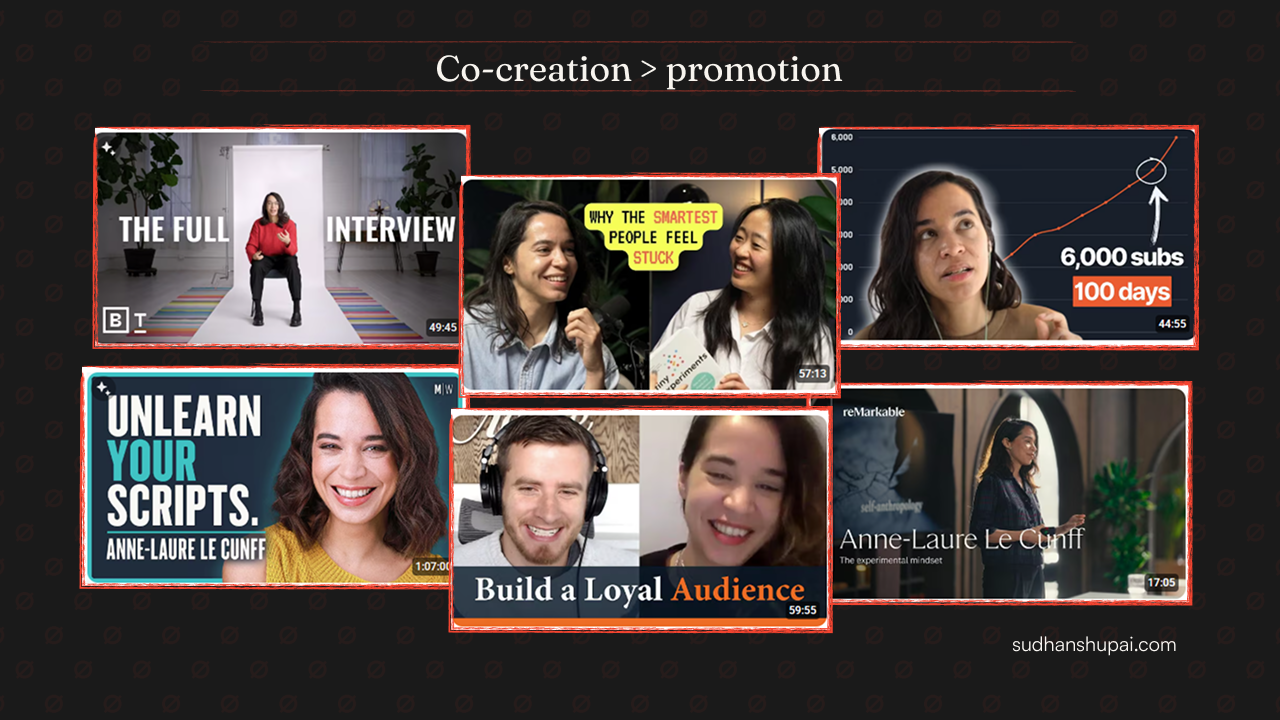
Anne-Laure didn’t “collab.”
She cross-pollinated.
🌐 1. Intellectual Affinity Groups
She worked with other neuro-nerds, learning scientists, and calm productivity freaks.
No clout. Just compatibility.
Each one unlocked micro-tribes who were already thinking her thoughts—they just needed someone to say them out loud.
🧭 2. Platform-Level Partnerships
Forget “collabs.” Think category anchoring.
- CogX (the Davos of deep tech)
- Leading Authorities (elite speaker circuit)
- Corporate learning teams who needed brains without burnout
She didn’t partner for reach.
She partnered for reputation gravity.
🎢 Product Launch Strategy: Emotional Lab Loops
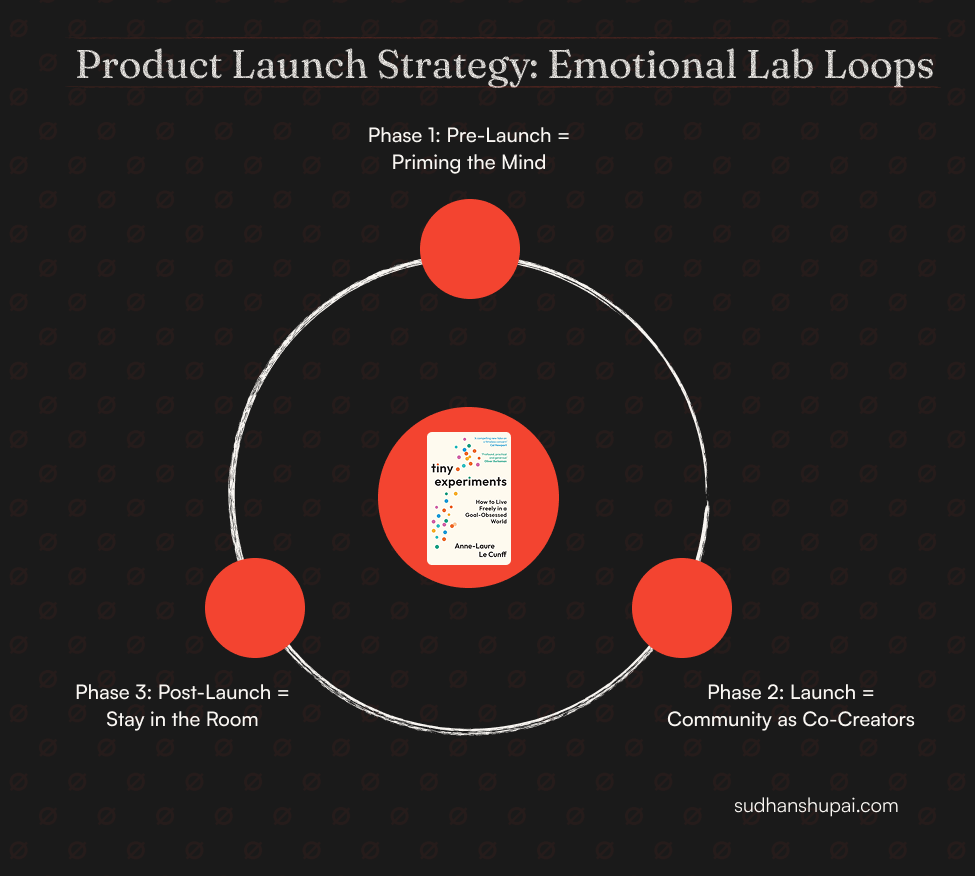
Anne-Laure doesn’t “launch.”
She invites participation in a living experiment.
Let’s break down her 3-phase model:
⚙️ Phase 1: Pre-Launch = Priming the Mind
- Plant strategic tension in the newsletter.
“Is your calendar killing your cognition?” → Enter: Tiny Experiments - Let the audience beta-test their own brains.
Early adopters weren’t buyers. They were co-investigators.
🚀 Phase 2: Launch = Community as Co-Creators
- Ness Labs members got first access.
Their feedback didn’t tweak the product.
It shaped its DNA. - Launch day wasn’t a reveal.
It was a reframing ceremony.
♻️ Phase 3: Post-Launch = Stay in the Room
- She didn’t ghost her products.
She evolved them.
Updates. Debriefs. Continued threads. Ongoing support.
Most creators drop a product like a mic.
Anne-Laure treats launches like long-term research studies.
🧩 TL;DR: Growth, But Make It Neuroethical
Anne-Laure’s marketing playbook isn’t a funnel.
It’s a trust engine that compounds over time.
| Principle | How It Shows Up |
| Clarity > Virality | SEO + Essays + Systems Thinking |
| Presence > Performance | Social content = reflections, not hooks |
| Borrowed Trust > Built Noise | Podcast guesting + platform partnerships |
| Participation > Promotion | Beta-first launches + audience feedback loops |
You don’t need to yell louder.
You just need to be more legible to the people who are already listening.
And we’re half way there…so take a breath and maybe…
Chapter 5: The Content Machine That Turned Thoughts Into Traction
“She didn’t publish to perform. She published to understand—
and that made her irresistible.”
There are two kinds of content creators:
- Those who chase the feed.
- Those who feed the mind.
Anne-Laure Le Cunff is unapologetically the latter.
Where most content machines run hot and shallow, hers runs slow and deep—like a geothermal idea reactor, quietly radiating trust.
She doesn’t write to be seen.
She writes to see clearly.
And that subtle shift makes all the difference.
🧱 Core Content Pillars: Thought as Infrastructure
Let’s walk through the idea machine—one thoughtful layer at a time.
🧠 1. Maker Mind Newsletter
The Weekly Ritual for Curious Brains
Over 200 essays in Year 1.
Each one a blend of:
- Cognitive science
- Personal curiosity
- Actionable mental models
Think: If Cal Newport and Tim Urban ran a mindful cult inside a Notion database.
But this wasn’t a “growth engine.”
It was a weekly permission slip to think better.
📖 2. Tiny Experiments — The Book
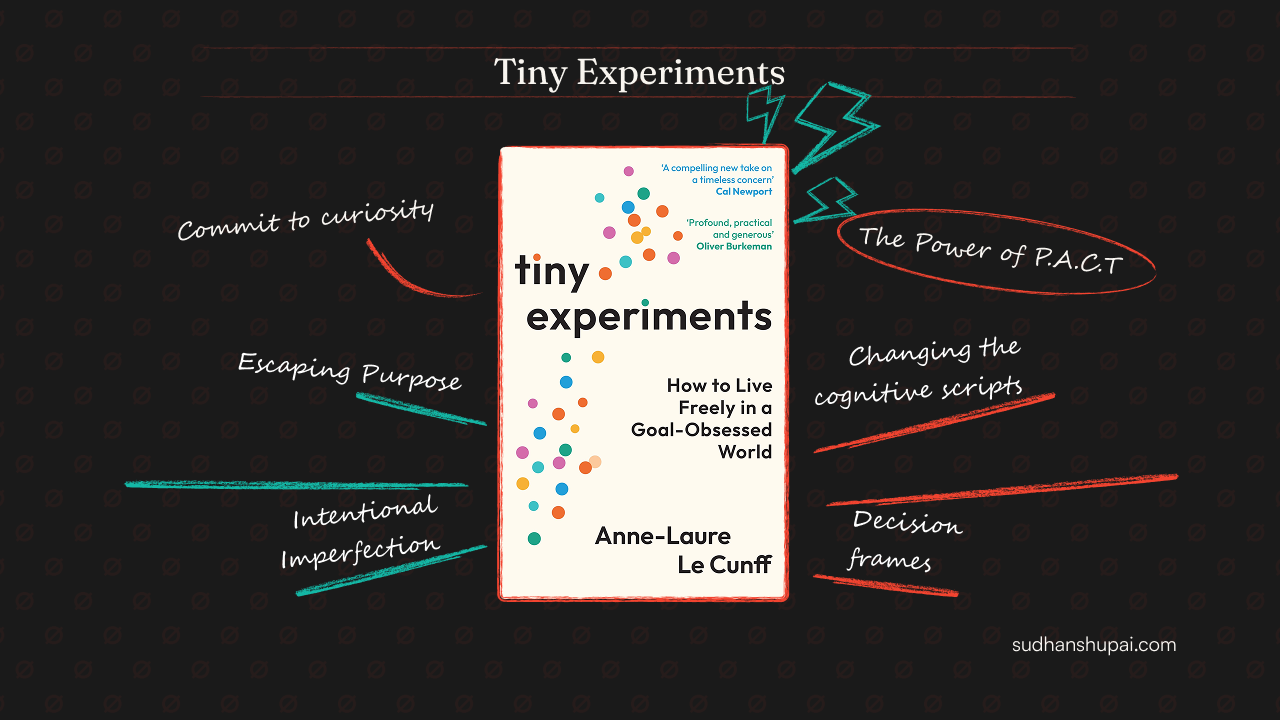
A Thesis in Disguise
Not a vanity play. No ghostwriting fluff.
This was her personal manifesto against goal obsession and productivity posturing.
“You don’t need goals. You need experiments.”
A line that launched a thousand Twitter threads—and quietly reframed how creators think about ambition.
This wasn’t a book.
It was a diagnosis.
And for many?
A prescription.
📚 3. Evergreen Power Posts
The Intellectual Infrastructure Beneath the Surface
Some blog posts aren’t “content.”
They’re foundational documents.
| Article | Function |
| “SMART goals are not so smart: make a PACT instead” | Smashes linear hustle logic |
| “Why learning how to learn is the skill behind all skills” | Blueprint for self learning |
| “Self-Authorship: The Art of Trusting Your Own Authority” | The mindset operating system |
These posts don’t expire.
They circulate—sent in DMs like “this explains everything.”
📦 Content Distribution: The Supply Chain of Thought
Anne-Laure didn’t “cross-post.”
She built a cognitive supply chain—with each channel reinforcing the others.
⚙️ Primary Channels
| Platform | Purpose |
| Newsletter | Weekly dispatch. Idea playground + backlinks. |
| Blog | Long-form SEO foundation. Link density = trust density. |
| Community (Circle) | Asynchronous lab + idea exchange. |
Each node is a layer in the idea immersion funnel.
🧩 Secondary Channels
- Twitter + LinkedIn → Micro-doses of reflection. Think pieces disguised as posts.
- Podcasts → Trojan Horse attention strategy. She enters your ears, exits with your curiosity.
- Guest Essays → Infiltration plays. Warm audiences who already think adjacent.
🛠️ Tools of the Trade
- ConvertKit → Segmentation + idea targeting.
- Circle → Digital soil for community-driven thinking.
The tools are invisible.
The experience is unforgettable.
✊ Engagement ≠ Comments. It = Cognitive Camaraderie.
Anne-Laure doesn’t “build audience.”
She builds shared inquiry.
Here’s how:
🧪 1. Interactive Workshops + Live Labs
Zooms that aren’t webinars.
They’re idea jam sessions.
Less keynote. More co-experimentation.
🔍 2. Radical Transparency = Trust Loop
She doesn’t hide her process.
She publishes her uncertainty.
Before conclusions, she shares questions.
Before products, she shares prototypes.
You’re not just watching her build.
You’re thinking it through with her.
🌟 3. Member Showcases
The community doesn’t revolve around her.
It mirrors back the collective intelligence of everyone inside.
Her brand isn’t a stage. It’s a cognitive co-op.
🔁 The Real World Contrast Table
Let’s contrast this with your average funnel-optimizing, click-optimizing content factory:
| Trait | Typical Creator | Anne-Laure |
| Launches | Sales stunt | Research collaboration |
| Content | Performative | Exploratory + science-backed |
| Engagement | Comments + Likes | Experiments + Feedback Loops |
| Funnels | Linear squeeze tactics | Circular curiosity trail |
| SEO | Afterthought | Content architecture from Day 1 |
🧠 TL;DR: Curiosity Is the Content Strategy
Anne-Laure didn’t build a content empire.
She built a thinking ecosystem—one essay, one framework, one experiment at a time.
Her strategy wasn’t:
- “Go viral.”
- “Own the niche.”
- “Dominate the market.”
It was:
“Make thinking contagious. Let content be the residue.”
Chapter 6: Brand Osmosis
(Aka How Anne-Laure Became the Internet’s Neuroscientist-in-Residence)
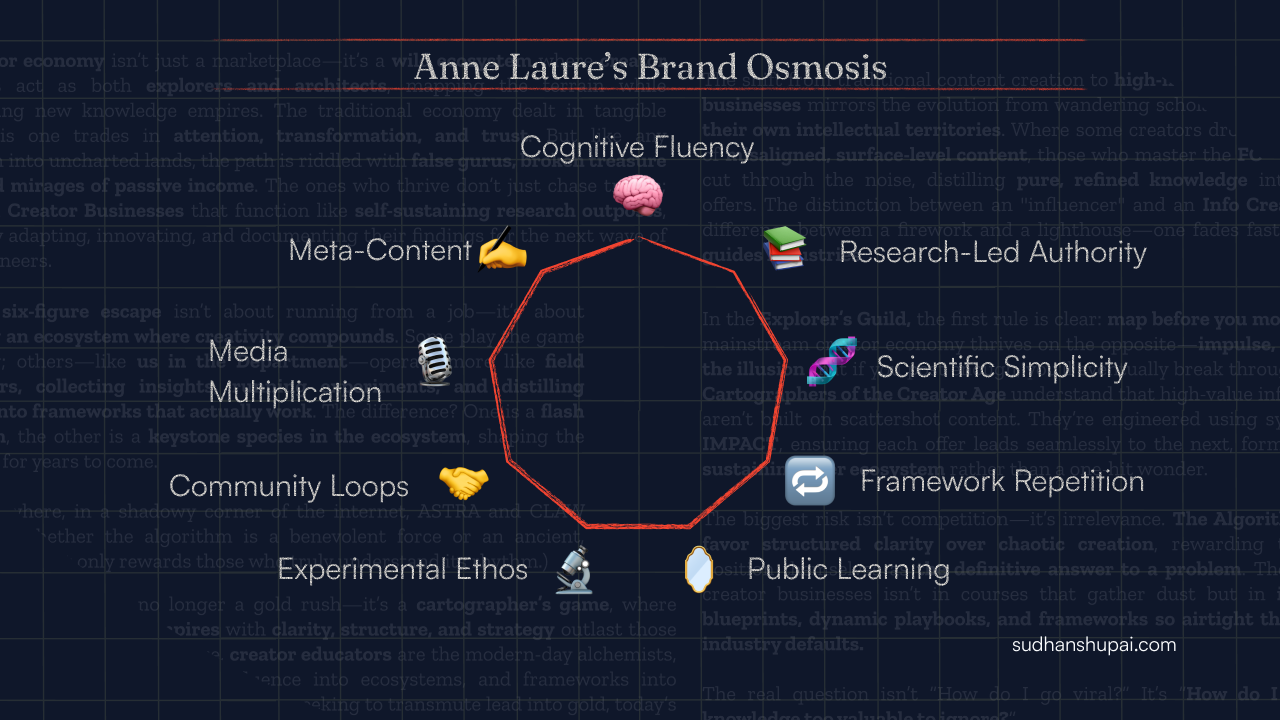
“You’re not just reading Ness Labs. You’re getting rewired by it.”
Some brands sell products.
Others sell you back to yourself — but upgraded.
Anne-Laure Le Cunff didn’t build a personal brand.
She built a self-authoring system.
Not a funnel. Not a vibe. Not a niche.
A neurological protocol that gently slips through your reticular activating system, throws on a lab coat in your prefrontal cortex, and begins reorganizing your internal monologue.
No shouty value posts.
No “hook, line, CTA” sorcery.
Just well-researched essays, deceptively soft frameworks, and community-powered cognition rituals that make you feel like you’ve always thought this way.
That’s not influence.
That’s brand osmosis.
🧠 Thought Leadership 3.0
Rooted in neuroscience.
Wrapped in vulnerability.
Distributed like software.
Anne-Laure didn’t just build trust.
She built mental fluency—a new way of thinking about thinking that’s now embedded in the cognitive OS of tens of thousands of curious humans.
Let’s dissect the system.
Or as she might say: let’s run a brain audit.
🧪 9 Osmosis Triggers Anne-Laure Deploys
| Trigger | What It Is | Why It Works |
| 🧠 Cognitive Fluency | Clean, sticky models (Mindframing, Mental Gym) | Your brain feels smarter just for understanding them |
| 📚 Research-Led Authority | Neuroscience + citations + lived thinking | Feels grounded—like a therapist who builds frameworks |
| 🧬 Scientific Simplicity | Academic ideas → daily practice | Instant application = dopamine spike without BS |
| 🔁 Framework Repetition | Recycles core ideas across formats | Repetition = identity reinforcement |
| 🪞 Public Learning | “I’m still figuring this out” tone | You feel with her, not beneath her |
| ⚗️ Experimental Ethos | Tiny Experiments > Masterplans | Encourages agency, not dependency |
| 🤝 Community Loops | 20K+ members reflecting the same ideas back | Social reinforcement = stickiness |
| 🎙️ Media Multiplication | Podcast guesting on value-aligned platforms | High-trust reach, no cringe |
| ✍️ Meta-Content | Writes about writing, thinking, learning | Her brand teaches you how to build brands like hers |
She’s not selling information.
She’s installing a scientific operating system for self-awareness.
📡 Authority Is an Osmosis Loop
It doesn’t look like authority.
It feels like remembering something you didn’t realize you knew.
The moment you read a Ness Labs essay, your brain runs this protocol:
READ → APPLY → FEEL SMARTER → SUBSCRIBE → PAY → QUOTE HER → THINK IT WAS YOUR IDEA
Authority = (Public Learning × Research Simplicity)ⁿ
Where “n” = Number of Identity Shifts Triggered
She’s not “known.”
She’s installed.
🌍 The Ness Effect, in Action
- 100K+ newsletter subscribers
- Thousands of course alumni
- Frameworks showing up in tweets, talks, and second brains across the web
Anne-Laure isn’t just “top of mind.”
She’s inside the mental models other people now teach.
Like a brain virus with ethical intentions.
And she did it without:
- Performative “value” posts
- Chasing engagement
- Growth hacks, dopamine tactics, or algorithm worship
This isn’t traction.
This is cognitive colonization by invitation.
⚔️ Why This Should Break Your Brain (In a Good Way)
While most creators optimize for virality, Anne-Laure optimized for identity formation.
Not “content.”
Cognitive conversion.
Not just education.
Internalization.
Here’s the difference:
| Treadmill Creator | Cognitive Creator |
| Optimizes for reach | Optimizes for resonance |
| Post daily tips | Builds a thinking style |
| Monetizes attention | Monetizes identity shifts |
| Teaches productivity | Installs personal protocols |
| Feeds the algorithm | Feeds your authoring loop |
This is how you build a Knowledge Asset Business.
Not a content treadmill. Not a personal brand.
A modular, teachable, neuro-brand.
🧭 My Brain, Mid-Sabbatical: A Confession
Sometime during my sabbatical—fried, scattered, creatively bankrupt—I realized:
I had been building funnels. Not frameworks.
No wonder they leaked.
Anne-Laure’s work hit me sideways.
Not as advice.
As an architectural slap.
It showed me that real influence isn’t about positioning.
It’s about pattern installation.
And that’s why Chapter 7 isn’t about content, or marketing, or monetization.
It’s about the protocol underneath it all.
The design logic behind the idea engine.
The Anne-Laure Protocol.
And how I’m rebuilding my own IP stack with it—one mental experiment at a time.
Chapter 7: The Anne-Laure Le Cunff Protocol
How to architect a creator brand like a self-evolving mind
Let’s not sugarcoat it:
Ness Labs is not a blog.
It’s a modular neurobusiness disguised as a newsletter.
Anne-Laure didn’t “monetize her content.”
She reverse-engineered a cognitive supply chain—part school, part system, part self-awareness OS—where each layer is recursive and every product teaches how to think, not just what to do.
And the genius?
It doesn’t scale like a funnel.
It scales like a thought virus—slow, sticky, and hard to shake once it’s in.
🧠 Core: The Recursive Infrastructure of a Thinking Brand
Most creators build content calendars.
Anne-Laure built a cognitive loop:
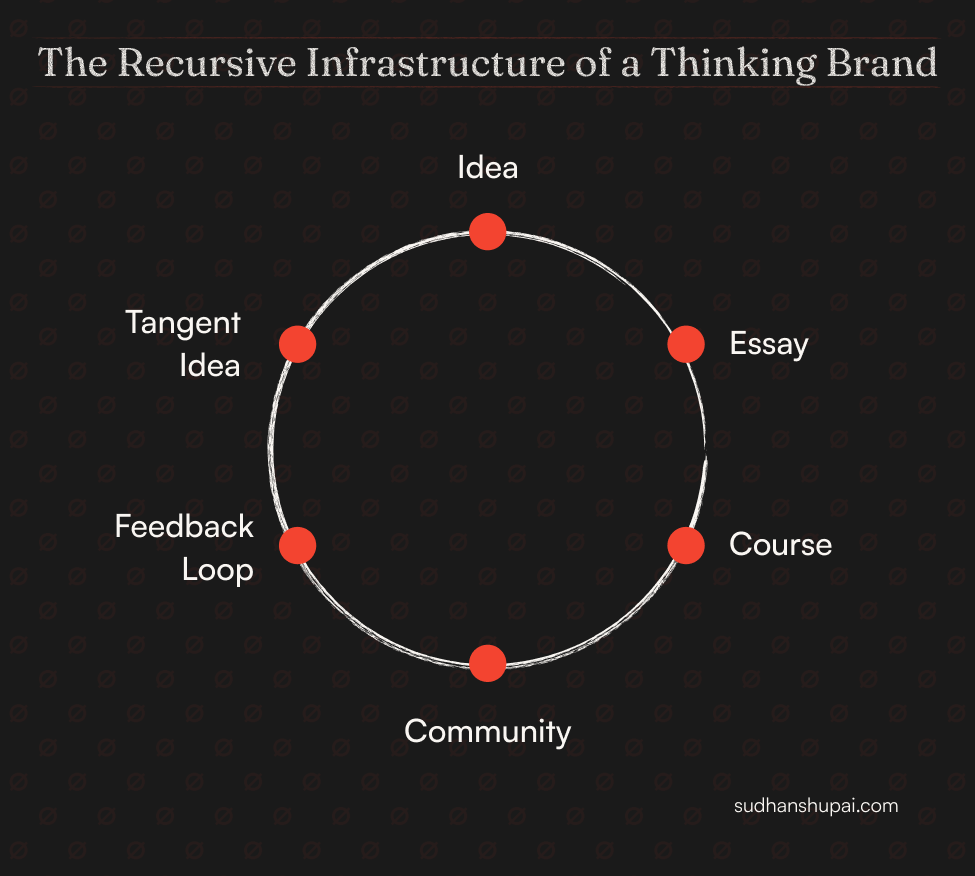
This isn’t top-down content.
It’s a living curriculum—each idea feeding the next, with products embedded like synapses in a thinking system.
Every newsletter = testbed
Every course = curriculum
Every community post = case study
Every feedback thread = R&D
Her brand doesn’t teach.
It self-evolves.
🔧 Tactical: The Modular Offer Stack (aka Intellectual UX)
Anne-Laure’s business isn’t stacked with offers.
It’s layered like a brain.
| Offer | Format | Function |
| Newsletter | Free | Trust engine, model distribution |
| Courses | $100–$300 | Teach methods, train mental muscles |
| Community | $149/year | Social reinforcement, co-thinking |
| Workshops & Coaching | Custom | B2B leverage, applied neurodesign |
| Speaking & Licensing | Global | IP scale, brand echo |
Each piece acts as an intellectual API—plug and play for different stages of curiosity.
And crucially:
She doesn’t just monetize what she knows.
She monetizes how she learns.
🧠 Mindset: Science, Not Self-Help
Anne-Laure doesn’t act like a marketer.
She operates like a cognitive architect.
Her core beliefs:
| Principle | Behavior |
| Experimentation > Execution | Every product is a prototype |
| Depth > Dopamine | No trend-chasing. No fake urgency. |
| Public Learning > Personal Branding | Readers are co-researchers, not followers |
This isn’t content. It’s permissionless academia—MIT meets meditation, Harvard meets habit design.
And it’s wrapped in a quote worth framing:
“Mindfulness isn’t about slowing down. It’s about noticing better.”
— Anne-Laure, Microsoft WorkLab
That’s not productivity.
That’s neuroplasticity as a brand promise.
🧩 From Funnel to Framework: Identity as the Product
Most creator businesses live inside what I call the Freelancer Flinch Loop:
Burnout → Build Course → Launch Dopamine → Plateau → Repeat
Anne-Laure flipped it:
Curiosity → Framework → Tiny Experiment → Insight → Identity Shift
That’s not content marketing.
That’s neuro-branding.
Because people don’t buy products.
They buy new ways of being.
She’s not just selling ideas.
She’s selling agency.
💥 What I’m Stealing (Adapting) from the Protocol
Here’s how I’m re-architecting my own creator engine using her mental blueprints:
- Scientific Framing → Every offer must rest on a real cognitive mechanism.
No fluff. Just behavioral scaffolding. - Audience as Cohort → Treat followers like co-investigators.
Write with, not at. - Framework-First Marketing → Start with a model.
Let the model do the marketing - Recursive Publishing → Essays become assets. Feedback becomes curriculum.
Products become new paradigms.
Because info products aren’t just scalable revenue.
They’re scalable reflections of how we think.
And how we help others think differently, too.
Epilogue: What We Talk About When We Talk About “Creator Economy”
A sobering look at what we’ve actually built
Let’s take a breath.
Not a scroll-break. Not a dopamine dump. An actual pause—to metabolize what we’ve witnessed across these case studies, protocols, and experiments in slow growth.
Because it’s not just content we’ve been analyzing.
It’s architecture.
What emerged wasn’t a hackathon of creator tools.
It was a blueprint for a different kind of business—one that reflects how you think, not just how you produce. One that doesn’t feed the algorithm, but feeds on attention in service of insight.
Most of what passes for “creator economy” today?
It’s not an economy. It’s a treadmill in drag.
The real cost of misaligned systems
This industry is flooded with tactics that work in the short term but fail to compound. We’ve mistaken visibility for value, and virality for velocity. The obsession with audience scale has smothered the more important—and often quieter—work of idea development.
During my sabbatical, I saw this in vivid detail.
High-agency, high-output creators who, despite having “made it,” were stuck inside an invisible factory. Not because they lacked motivation—but because their business models were secretly hostile to their cognition.
They hadn’t built freedom.
They had just rebuilt the job they fled—this time, with prettier dashboards.
What Anne-Laure and Katelyn really figured out
What unites creators like Anne-Laure and Katelyn isn’t just polish or platform mastery.
It’s the fact that they built belief systems, not just products. They productized insight. They made behavioral gravity their true business model.
And that’s what differentiates a content business from a Cognitive Company.
One fights for reach. The other becomes a lens you see the world through.
💡 From Content Creator to Cognitive Architect
So what’s the shift?
From being seen…
To seeing clearly.
From chasing eyeballs…
To architecting belief-based businesses.
From “what’s your niche?”
To “what’s your paradigm?”
Let’s call it the Cognitive Company Equation:
Insight Density × Intellectual Asset Velocity = Scalable Signal
| Variable | Meaning |
| Insight Density | How deep, rare, and useful your thinking is |
| Asset Velocity | How fast you turn insight into products, systems, and experiences |
| Scalable Signal | When your ideas spread without your name attached |
This is the new game.
Where IP is the influencer.
Chapter 8: Conclusion – The Rise of the Info Creator
A new definition of leverage
Here’s the shift I’m now building around—and inviting others into:
A Cognitive Company is a thinking engine wrapped in infrastructure.
It monetizes pattern recognition, not personal performance.
It doesn’t sell you. It sells new ways to think.
In this model:
- Insight becomes infrastructure
- Frameworks become flywheels
- Content becomes cognitive scaffolding
The result is a business that outlasts the algorithm and scales without sacrificing selfhood.
Not because it’s optimized.
But because it’s architected to reflect how you naturally think.
From funnels to frameworks
When I looked back at what wasn’t working, the failure wasn’t in the execution. It was in the underlying shape of the business.
Funnels leak.
Frameworks compound.
The creators who win long-term aren’t simply more consistent.
They’re more coherent—in belief, in model, in brand philosophy.
They stop trying to be everywhere, and start becoming unmistakable to the people already listening.
A blueprint-in-progress (for both of us)
This whole essay wasn’t just an analysis of others.
It was a confession. And a rebuild.
I’ve screwed this up before—built for speed, not signal.
Now, I’m doing it differently. Slowly. In layers.
Trading noise for narrative.
Content for cognition.
Funnels for frameworks.
And if anything in this resonated, it’s likely because you’re already on that same road.
So don’t just build a personal brand.
Build a thinking system people want to live inside.
Don’t just create content.
Create containers for transformation.
Let’s stop chasing reach.
Let’s start building resonance.
(Writing this piece has taken me upwards of 300+ hours, from all the research to making sense of things and putting it up in a slightly easy-to-digest format.
So for some reason, if you decide to share this piece of content with others on social, it’ll be appreciated (and won’t go unnoticed, so thank you).

Sudhanshu Pai
Sudhanshu Pai is the writer of THE INFO CREATOR DEPT. He spends his days researching knowledge business, creators economy, why & how 7 fig info business scale (or flop) and generally figuring out blueprints, breakthroughts and strategies to help creator educators get higher return on their expertise.
The deep dives and other content take more than 100 hours to put together, so sharing this content with others on social media will be much appreciated (and won’t go unnoticed.)

